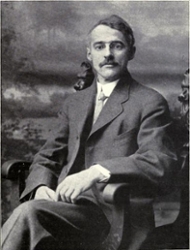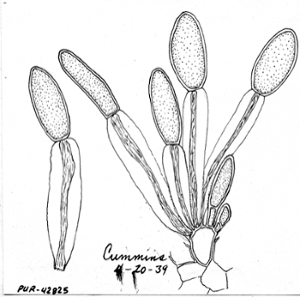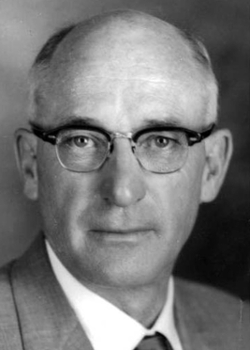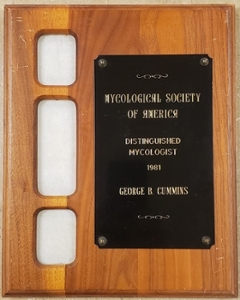"The Burned-Out Botanist": George Baker Cummins (1904–2007)

George B. Cummins, affectionately known as Mr. Rust among his colleagues at Purdue University, was recognized throughout the world as the authority on the rust fungi Puccinales. His numerous publications dated from 1930 to 2003 and were lauded in his memorial in Mycologia: "During these 73 years George compiled a record of professional accomplishments that will stand as his monument in the history of mycology."
Early Life and Collegiate Studies
George Baker Cummins was born on August 29, 1904 in Tecumseh, Nebraska. Cummins was the second child of George Wilson Cummins and Nellie Baker Cummins, whom had a daughter, Ruth, 3 years before. The four moved to western Montana in 1906 to a 100-acre farm in the Bitterroot Valley town of Darby. The family tended the farm with horses and their own ingenuity, raising pigs, chickens, and cows, and growing potatoes, cereal grains, cherries, apples, and a large vegetable garden. Cummins attended Darby secondary schools, played on the high school basketball team, and graduated high school in a class of 13 in 1922.

Cummins continued playing basketball while attending Montana State College (MSC, now University), originally planning on obtaining a degree in engineering, but instead found an interest in botany and bacteriology. In the summer during college, Cummins worked for the U. S. Department of Agriculture in his introduction to rust fungi-related field work, driving a Ford Model-T throughout the state of Montana, removing barberry to control stem rust of wheat. Cummins completed his B. S. program in 1927 from MSC, where he had gained the attention of Frank B. Comer, a student of mycologist Calvin H. Kauffman at the University of Michigan. Comer worked to introduce the two, and Cummins started a graduate program with Kauffman in 1927. Cummins lived in the attic of the Kauffmans' house during his time in Ann Arbor, charged with helping Kauffman's wife, Elizabeth Catherine Kauffman, with work around the house and, most importantly, to wake at 5AM and get the furnace started and running throughout the day. Kauffman was demanding of his students, expecting long, late hours in the lab. When Kauffman complained that Cummins, seeking 8 hours of sleep, was abandoning his tasks too early in the evening, Cummins countered that if Kauffman expected a warm house, and to perhaps avoid the displeasure of his wife, that he be allowed to bed early. Kauffman did not broach the subject to Cummins further.
Cummins's first publication was the result of his master's degree program, focused on the discomycetes fungi of the Flathead National Forest in Montana, which he studied while spending a summer at the Echo Lake Ranger Station of the U. S. Forest Service. Evident of Cummins's wit and self-effacing humor, he would note with some pleasure that this work remained largely unknown and uncited. Later in his life it was cited once, in a 1997 systematic revision of the Helvellaceae fungi of northwestern North America. Cummins completed his M.S. in 1930.
Purdue University

E. B. (Edwin Butterworth) Mains, another student of Kauffman's, was a faculty member at Purdue University and reached out to his former mentor to ask his recommendations of a qualified individual to assist Joseph C. Arthur with the completion of his 1934 Manual of Rusts in United States and Canada. Cummins began at Purdue in 1930 for what he believed to be a temporary position, but any hopes of returning to Kauffman's lab at the University of Michigan were devastated by Kauffman's death in 1931. Further, plans to become Mains's student were dismissed when Mains was recruited by the University of Michigan to replace Kauffman. Cummins was never a student of Arthur's, referring to himself as Arthur's "nursemaid", but he worked with several advisors at Purdue University to continue his education, when he was not occupied with preparing the Manual. In assisting Arthur, Cummins honed his skills at microscopy and illustration via a camera lucida, helped prepare species keys and descriptions, and proofread Arthur's work, often reading it back aloud to Arthur for his approval. Though only acknowledged by Arthur briefly in the preface, Cummins would produce supplements for later editions of the Manual and was more widely recognized for his contributions. Cummins completed his Ph.D. in 1935.

Cummins remained at Purdue University, tenured as Professor in 1947, and was Head of the Department of Botany and Plant Pathology from 1966 until his retirement in 1970, after which he was recognized as Emeritus Professor in 1971. Cummins also served as Director of the Arthur Fungarium (PUR) for nearly all of his time (1938–1970) at Purdue University. While at Purdue University he published 117 papers and a handful of books, describing 470 new rust fungi taxa from the Philippines, New Guinea, China, the Himalayas, central and western Africa, and North and South America. His students included several other urediniologists, including Joseph F. Hennen, future Director of the PUR (1971–1995). Cummins's expertise on the rusts placed him in a foremost position during the "Green Revolution". Most plant breeding programs were concerned with developing new varieties resistant to diseases, particularly diseases caused by rust fungi. His contributions served as the major background material for these breeding programs. Thus, his impact on the vast increase in food and fiber that occurred in the mid-20th century was truly monumental.
Cummins held all of the offices of the Mycological Society of America (MSA); among them, he was President in 1946. He was also active in the American Phytopathological Society, the Mycological Society of Mexico, the Torrey Botanical Club, the American Society of Plant Taxonomists, the Southwestern Association of Naturalists, the Indiana Academy of Science, and the International Association for Plant Taxonomy. He was made a Life Member of the MSA in 1967, and at the time of his death he was considered the longest surviving charter member of the Society. His achievements were recognized by Montana State University (where he received a B.S. degree) when they conferred upon him an Honorary Doctor of Science degree in 1963.
Familial Life

Yellow Bay, Flatwood Lake, Montana, 1956. Mycologia.
In addition to completing his M. S. degree program and joining Purdue University in 1930, Cummins married Margaret Elizabeth Sempill of Lafayette, Indiana that fall. The couple had two children, Richard (b. 1934) and Elaine (b. 1936), before Margaret died in 1936 at the age of 28. Cummins then met Mildred Shriver, a 1929 Purdue University graduate and high school teacher. She and Cummins were married in 1938, and she was a devoted wife and mother to Cummins and his children for the rest of her life. In 1957, Cummins spent weeks collecting rust fungi from the Chiricahua Mountains of southeastern Arizona, and in 1960 he spent a year-long sabbactical in Tucson, Arizona. These visits seemed to have made an impression on him, as he and Mildred moved to Tucson after his retirement from Purdue University in 1971.
A Prolific Retirement

Shortly after his move to Tucson, Cummins was appointed a visiting research professor in the Department of Plant Pathology at the University of Arizona, which provided him space and equipment in their fungarium. In the next 20 years, Cummins would publish an additional 22 papers and 5 books, the last of which he published in 2003 at the age of 99. Cummins remained in contact with the faculty and staff of Purdue University for years to come, signing letters as "the burned-out botanist". In recognition as the foremost authority on the rust fungi, Purdue University awarded him an honorary doctoral degree in 1981 and several other universities also awarded him honorary degrees. That year Cummins was honored as one of the inaugural recipients of the MSA Distinguished Mycologist Award, the highest award bestowed by the Society, recognizing an outstanding career devoted to quality research and service to the field of mycology. George B. Cummins died March 30, 2007, in Tucson, Arizona at the age of 102. After his death, Markus Scholler, Curator of the PUR (1999–2002), stated "Dr. George B. Cummins is a scholar, a gentlemen, and a scientist of international fame. His contributions to Purdue University, Indiana, the United States, and the world have been enormous." Mildred passed away on August 8, 2008, survived at that time by both of their children, six grandchildren, and eight great-grandchildren.
George Baker Cummins. Wikipedia. Link here.
George Baker Cummins papers. Purdue University Archives and Special Collections. Link here.
Gilberton RL, Blackwell M. 2009. George Baker Cummins 1904–2007. Mycologia 101: 745–749. Link here.
McCain JW, Hennen JF. 1982. The Arthur Herbarium centennial: 100 years of uredinology in Indiana and the Great Lakes Region. Proceedings of the Indiana Academy of Science 92: 389–395. Link here.
